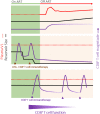Harnessing CD8+ T Cells Under HIV Antiretroviral Therapy
- PMID: 30863403
- PMCID: PMC6400228
- DOI: 10.3389/fimmu.2019.00291
Harnessing CD8+ T Cells Under HIV Antiretroviral Therapy
Abstract
Antiretroviral therapy (ART) has transformed HIV from a fatal disease to a chronic condition. In recent years there has been considerable interest in strategies to enable HIV-infected individuals to cease ART without viral rebound, either by purging all cells infected harboring replication-competent virus (HIV eradication), or by boosting immune responses to allow durable suppression of virus without rebound (HIV remission). Both of these approaches may need to harness HIV-specific CD8+ T cells to eliminate infected cells and/or prevent viral spread. In untreated infection, both HIV-specific and total CD8+ T cells are dysfunctional. Here, we review our current understanding of both global and HIV-specific CD8+ T cell immunity in HIV-infected individuals with durably suppressed viral load under ART, and its implications for HIV cure, eradication or remission. Overall, the literature indicates significant normalization of global T cell parameters, including CD4/8 ratio, activation status, and telomere length. Global characteristics of CD8+ T cells from HIV+ART+ individuals align more closely with those of HIV-seronegative individuals than of viremic HIV-infected individuals. However, markers of senescence remain elevated, leading to the hypothesis that immune aging is accelerated in HIV-infected individuals on ART. This phenomenon could have implications for attempts to prime de novo, or boost existing HIV-specific CD8+ T cell responses. A major challenge for both HIV cure and remission strategies is to elicit HIV-specific CD8+ T cell responses superior to that elicited by natural infection in terms of response kinetics, magnitude, breadth, viral suppressive capacity, and tissue localization. Addressing these issues will be critical to the success of HIV cure and remission attempts.
Keywords: CD8 T cell; HIV; HIV cure strategies; aging; antiretroviral therapy (ART); immunosenescence; vaccines.
Figures

Similar articles
-
CD8+ T Cell Breadth and Ex Vivo Virus Inhibition Capacity Distinguish between Viremic Controllers with and without Protective HLA Class I Alleles.J Virol. 2016 Jul 11;90(15):6818-6831. doi: 10.1128/JVI.00276-16. Print 2016 Aug 1. J Virol. 2016. PMID: 27194762 Free PMC article.
-
HIV replication leads to skewed maturation of CD8-positive T-cell responses in infected children.New Microbiol. 2010 Oct;33(4):303-9. New Microbiol. 2010. PMID: 21213588
-
Post-Treatment Controllers: Role in HIV "Cure" Research.Curr HIV/AIDS Rep. 2016 Feb;13(1):1-9. doi: 10.1007/s11904-016-0296-x. Curr HIV/AIDS Rep. 2016. PMID: 26781112 Review.
-
Interferon Alpha Enhances NK Cell Function and the Suppressive Capacity of HIV-Specific CD8+ T Cells.J Virol. 2019 Jan 17;93(3):e01541-18. doi: 10.1128/JVI.01541-18. Print 2019 Feb 1. J Virol. 2019. PMID: 30404799 Free PMC article.
-
T-cell exhaustion in HIV infection.Immunol Rev. 2019 Nov;292(1):149-163. doi: 10.1111/imr.12823. Immunol Rev. 2019. PMID: 31883174 Free PMC article. Review.
Cited by
-
Effects of Brief Adjunctive Metformin Therapy in Virologically Suppressed HIV-Infected Adults on Polyfunctional HIV-Specific CD8 T Cell Responses to PD-L1 Blockade.AIDS Res Hum Retroviruses. 2021 Jan;37(1):24-33. doi: 10.1089/AID.2020.0172. Epub 2020 Nov 5. AIDS Res Hum Retroviruses. 2021. PMID: 33019813 Free PMC article. Clinical Trial.
-
[Abnormal Activation of T Cells in HIV-1 Infection After Antiretroviral Therapy].Sichuan Da Xue Xue Bao Yi Xue Ban. 2023 Mar;54(2):415-421. doi: 10.12182/20230360208. Sichuan Da Xue Xue Bao Yi Xue Ban. 2023. PMID: 36949708 Free PMC article. Chinese.
-
Pre-cART Immune Parameters in People Living With HIV Might Help Predict CD8+ T-Cell Characteristics, Inflammation Levels, and Reservoir Composition After Effective cART.Pathog Immun. 2021 Oct 1;6(2):60-89. doi: 10.20411/pai.v6i2.447. eCollection 2021. Pathog Immun. 2021. PMID: 34988339 Free PMC article.
-
Influence of cytokines on the recovery trajectory of HIV patients on antiretroviral therapy: A review.Medicine (Baltimore). 2025 Jan 3;104(1):e41222. doi: 10.1097/MD.0000000000041222. Medicine (Baltimore). 2025. PMID: 40184131 Free PMC article. Review.
-
Impact of Early ARV Initiation on Relative Proportions of Effector and Regulatory CD8 T Cell in Mesenteric Lymph Nodes and Peripheral Blood During Acute SIV Infection of Rhesus Macaques.J Virol. 2022 Apr 13;96(7):e0025522. doi: 10.1128/jvi.00255-22. Epub 2022 Mar 21. J Virol. 2022. PMID: 35311550 Free PMC article.
References
Publication types
MeSH terms
Substances
Grants and funding
LinkOut - more resources
Full Text Sources
Medical
Research Materials
Miscellaneous

